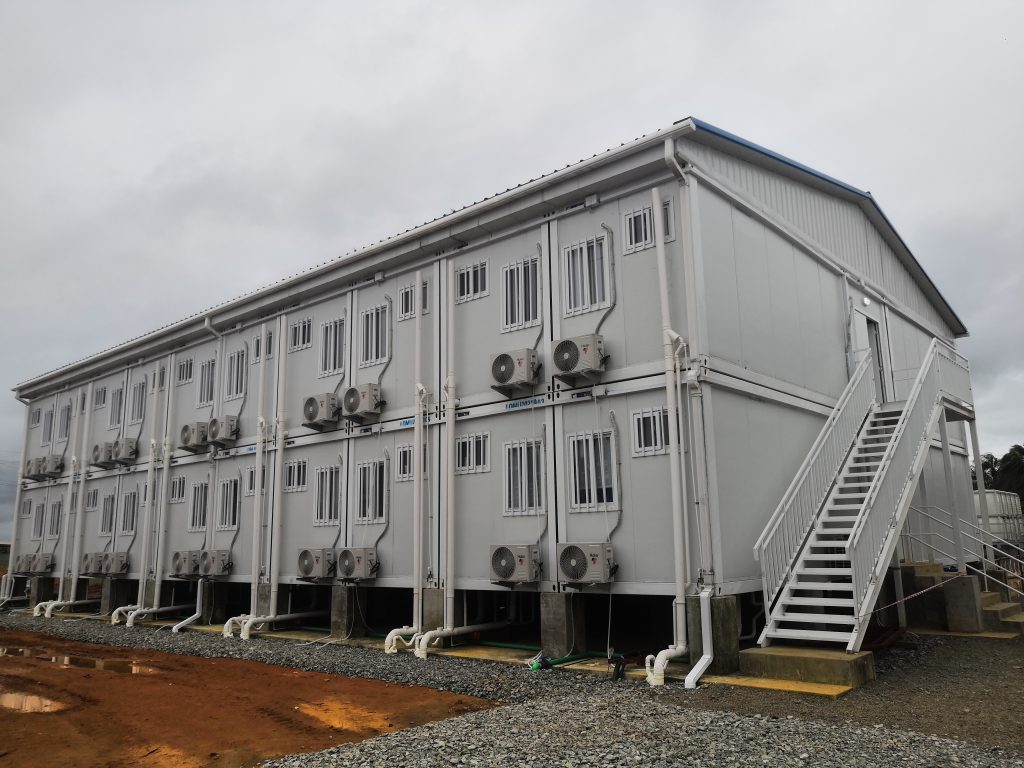Introduction: Understanding the Concept of Container Labor Camps
Container labor camps, also known as modular accommodation or portable labor camps, have become an essential solution for providing temporary housing to the workforce in various industries. These camps are designed using shipping containers that are converted into living spaces, offering a cost-effective and flexible alternative to traditional construction methods.
In this section, we will delve into the concept of container labor camps and explore their significance in addressing the growing demand for workforce housing. We will discuss their benefits, use cases, and how they have revolutionized the way temporary worker housing is approached.
Whether it’s for construction projects, mining operations, or remote work sites, container labor camps have proven to be a practical solution for accommodating workers efficiently and comfortably. So let’s dive in and discover how these innovative structures are shaping the landscape of temporary worker housing.
The Benefits of Container Labor Camps for Employers and Workers
Container labor camps offer a range of benefits for both employers and workers, making them a cost-effective and practical solution for workforce accommodation. These camps provide flexible living arrangements that can be easily adjusted to meet the needs of different projects and workforce sizes.
One key advantage is the quick setup and dismantling of container labor camps. Employers can save valuable time and resources by rapidly deploying these camps, allowing them to respond swiftly to changing project demands or locations. This flexibility ensures that workers have suitable living conditions wherever they are needed.
Furthermore, container labor camps prioritize safety and security. These camps are designed with durable materials that meet stringent construction standards, providing a secure environment for workers. They often include features such as surveillance systems, access control measures, and fire safety equipment to ensure the well-being of all occupants.
In addition to cost-effectiveness and flexibility, container labor camps also contribute to improved worker morale. By providing comfortable living spaces with essential amenities such as sleeping quarters, dining areas, recreational facilities, and sanitary facilities, these camps create a more conducive environment for rest and relaxation after long work hours.
Overall, container labor camps offer numerous advantages for employers seeking efficient workforce accommodation solutions. From their cost-effectiveness and flexibility in setup to their focus on safety and security, these camps provide an optimal living arrangement for workers while maximizing productivity on-site.

Innovative Features and Design Elements in Container Labor Camps
Container labor camps have evolved significantly in recent years, incorporating innovative features and design elements that prioritize sustainability, efficient space utilization, and comfortable living conditions. These advancements have not only enhanced the overall experience for workers but also improved their well-being during their stay.
One of the key aspects of modern container labor camps is the use of sustainable building materials. By opting for eco-friendly materials such as recycled steel containers and renewable energy sources like solar panels, these camps reduce their carbon footprint and promote a greener environment.
Efficient space utilization is another crucial aspect of these camps. Designers now focus on maximizing every inch of available space to accommodate more workers while maintaining privacy and comfort. Cleverly designed layouts ensure that each individual has sufficient personal space, storage areas, and common areas for socializing.
Comfortable living conditions are paramount in container labor camps. The interior design incorporates ergonomic furniture, proper ventilation systems, and insulation to regulate temperature effectively. Additionally, soundproofing measures are implemented to minimize noise disturbances from nearby activities or neighboring units.
Recognizing the importance of recreation and well-being, modern container labor camps also include recreational facilities and amenities within their premises. These may include gyms, sports fields, communal gathering spaces, libraries, and even entertainment zones. Such provisions aim to promote a healthy work-life balance among residents.
In conclusion, innovative features and design elements have revolutionized container labor camps by prioritizing sustainable building materials, efficient space utilization techniques, comfortable living conditions through proper insulation and ventilation systems while providing recreational facilities for workers’ well-being. These advancements not only enhance the overall experience but also contribute to a more productive workforce in these environments.

The Role of Container Labor Camps in Meeting the Growing Demand for Temporary Housing
Container labor camps play a crucial role in meeting the growing demand for temporary housing in various sectors such as rural development projects, construction sites and mining operations, disaster relief efforts, and seasonal agricultural workforce. These camps provide a practical and cost-effective solution to accommodate workers in remote locations or areas where traditional housing options are limited.
In rural development projects, container labor camps offer a convenient solution for accommodating workers who are involved in infrastructure development, road construction, or other community-building initiatives. These camps can be quickly set up and provide essential amenities such as sleeping quarters, dining facilities, and sanitation facilities.
Similarly, in construction sites and mining operations, container labor camps serve as temporary housing for workers who are engaged in large-scale projects. These camps ensure that the workforce is readily available on-site while minimizing logistical challenges associated with commuting long distances.
During disaster relief efforts, container labor camps prove invaluable by providing immediate shelter to displaced individuals. In times of crisis or natural disasters, these camps can be rapidly deployed to provide safe and comfortable living conditions for affected populations until more permanent solutions can be implemented.
Furthermore, container labor camps also cater to the needs of seasonal agricultural workforces. In regions where agriculture heavily relies on seasonal laborers for planting or harvesting crops, these camps offer a practical solution for accommodating workers during peak farming seasons. This ensures that farmers have access to a reliable workforce while providing suitable living conditions for the agricultural workers.
In conclusion, container labor camps play an essential role in meeting the growing demand for temporary housing across various sectors. Their flexibility, affordability, and quick setup make them an ideal choice for accommodating workers involved in rural development projects, construction sites and mining operations, disaster relief efforts, and seasonal agricultural workforces.

Evaluating the Economic and Social Impacts of Container Labor Camps on Local Communities
Container labor camps have become a prominent solution to address the need for job creation opportunities in remote areas. These camps not only provide employment to local communities but also contribute to the economic growth of these regions. By establishing these camps, companies can bring jobs closer to the workforce, reducing the need for long-distance commuting and improving work-life balance.
One significant advantage of container labor camps is their ability to support local businesses and services. As these camps are often located in remote areas, they create a demand for goods and services that were previously limited or nonexistent in those communities. This stimulates entrepreneurship and helps small businesses thrive, leading to increased economic activity and prosperity.
Furthermore, container labor camps help minimize strain on existing infrastructure in urban centers. By decentralizing job opportunities, these camps alleviate pressure on transportation networks, housing markets, and public services in densely populated areas. This redistribution of workforce reduces overcrowding and allows cities to focus on improving infrastructure for their permanent residents.
It is important to evaluate both the economic and social impacts of container labor camps on local communities. While they offer job opportunities and boost local economies, it is crucial to ensure fair working conditions, adequate housing facilities, and access to essential amenities for workers residing in these camps.
Overall, container labor camps can play a significant role in creating employment opportunities in remote areas while supporting local businesses and minimizing strain on existing infrastructure. Careful evaluation of their economic and social impacts is necessary to ensure that they contribute positively towards sustainable development for both the workers and the host communities.

The Future Outlook: Advancements in Container Labor Camp Technology and Adaptability to Changing Needs
The future of container labor camps is set to be revolutionized by advancements in technology. With the integration of smart container systems, these camps are becoming more adaptable to changing needs and requirements.
One key aspect is the customization options available for different industries. Whether it’s construction, mining, or disaster relief, these smart containers can be tailored to meet specific demands. From modular layouts to advanced features like climate control and security systems, the possibilities are endless.
The integration of technology within these container labor camps allows for efficient monitoring and management. Real-time data collection enables better resource allocation and optimization. For instance, energy consumption can be monitored and adjusted based on actual usage patterns, leading to cost savings and environmental sustainability.
Moreover, the adaptability of these smart containers extends beyond physical infrastructure. They can also integrate with various software systems to streamline operations further. This means seamless connectivity between different departments or even remote management from a central location.
In conclusion, the future outlook for container labor camp technology is promising. The advancements in smart container systems with integration and customization options will cater to diverse industries’ needs while ensuring efficiency and adaptability in an ever-changing world.
Conclusion: Embracing the Potential of Container Labor Camps for Enhanced Workforce Accommodation Solutions
In conclusion, the potential of container labor camps for enhanced workforce accommodation solutions cannot be overlooked. These camps offer a practical and cost-effective solution to address the housing needs of a growing workforce.
Container labor camps provide a safe and comfortable living environment for workers, ensuring their well-being and productivity. They are designed to meet all necessary standards and regulations, providing essential amenities such as sleeping quarters, dining areas, recreational spaces, and sanitary facilities.
By embracing the potential of container labor camps, companies can effectively manage their workforce accommodation needs. These camps can be easily transported and set up in remote or temporary locations, making them ideal for construction sites, mining operations, disaster relief efforts, and other industries that require temporary housing solutions.
Furthermore, container labor camps offer flexibility in terms of scalability. As the workforce size fluctuates, additional containers can be added or removed accordingly. This allows companies to optimize their resources and accommodate varying numbers of workers without compromising on comfort or safety.
In addition to their practicality and versatility, container labor camps also contribute to sustainability efforts. Many of these camps are constructed using repurposed shipping containers, reducing waste and promoting eco-friendly practices.
Overall, embracing the potential of container labor camps is a forward-thinking approach that addresses the challenges associated with workforce accommodation. By investing in these innovative solutions, companies can ensure that their employees have suitable living conditions while maximizing operational efficiency.

Related news
-
The Advantages of Prefab Houses: Why You Should Consider Choosing a Prefabricated Home
2023-08-29 16:40:12
-
The Future of Construction: Exploring the Benefits of Lida Group's Container Houses and Prefab Buildings
2023-08-28 15:14:53
-
Steel Structures combine Aesthetics with Sturdy Performance for Unique Floor Plans and Large Clear Spans
2023-08-25 14:51:30
contact us
- Tel: +86-532-88966982
- Whatsapp: +86-13793209022
- E-mail: sales@lidajituan.com


